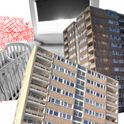What do you feel when you get a new passport? Sad and excited—and also, intrigued. My old passport was nearly as old as this age of terror. It is striking how the intervening years—a decade of paranoia about migration and data insecurity—have stamped, so to speak, the replacement that plopped through the letterbox this week.
The new British passport addresses anxieties about identity in more than just the proliferation of embedded microchips, shimmering holograms and intricate, subtly-coloured, photocopier-thwarting details. A British passport is now, as for some time, a carefully prescribed variation on a standard European paradigm.
The very document that asserts your status as a citizen of a sovereign nation is becoming ever more global—an object metaphor, you could say, for the postmodern disposition of international affairs. We have come far from the old, large-format, black leather passports Britons touted in the 1970s—yet such nostalgia is felt for these that a brisk trade is done in passport holders gussied up to resemble them.
The passport itself seems to gesture at that anxiety—to try to compensate. The blank pages of my last passport are coloured in pastel greens and pinks in swirling geometric patterns, as if created by a computerised Etch A Sketch. The pages of the new one, in a similar palette, are themed. Each offers one piece of a slightly twee jigsaw of fantasy Britishness (or Englishness, as it seems more directly tilted).
In the front, “Her Britannic Majesty’s Secretary of State Requests and Requires…” above a row of Cotswold cottages sleeping behind a neat border of shrubs. A purple butterfly roosts on an oak-leaf. Successive pages—if you rotate the passport through 90 degrees—are titled “Reedbed,” “Geological Formation,” “Coastal Cliff,” “Fishing Village,” “Beach,” “Canal,” “Village Green,” “Formal Park,” “Woodland,” “Lake,” “River,” “Moorland” and “Mountain.” In the details, salmon jump, owls roost and dragonflies hover. We see sundials, park benches, thatched houses and beach-huts facing the sea.
Over it all is—I suppose the thing we are famed for—the weather. Isobars snake across these designs. Integrated into the head of each page is a dinky weather-map icon: a plump schematic cloud with two fat drops of rain issuing from it, or bars radiating from one of its three lobes to indicate the sun coming out. Strange, what this implies. Everywhere you go, as Crowded House sang, you always take the weather with you: you carry Britain in your passport, a pocketful of off-the-peg metonymies for the global citizen.
Passports are communal, but they are also personal. Getting a new one makes you look at the old one. There’s my face, again. Ten years, it should be said, is a cruel interval at which to take identically posed photos. Two passports ago you could see a face just emerging from childhood, from what it used to be; with the new one, you can see the face—under the holographic gleam—hardening into what it’s going to become.
If I look conscious of that in the photo, it’s an accident. They’ve changed the rules and you’re not allowed to smile any more. The old joke was that if you look like your passport snap you’re too ill to travel: now, if you look like your passport snap you’re too unhappy for travel to do you any good.
I remember where I was when my last passport came back. I was in west London, waiting. It was the first week of January, and the moment a courier arrived with my new passport, stamped with a ten-year visa for the US, I was to get on a plane to New York to work as a correspondent for my then newspaper. The passport is the record of a decade in which I travelled greedily, often and abruptly, and packed light.
I went to Norway to report on the Royal Marines, Australia to report on Katie Price, St Petersburg and Sri Lanka to see friends married. These stamps are code for holidays, romances, jobs, break-ups, the longueurs and excitements of airports. It makes me think of the wonderful cantering pentameter with which WH Auden ends his poem “New Year Letter”: “The world’s great rage, the travel of young men.”
That face has yet to meet its children: not the faintest inkling of who they are, of who their mother will be, of where their father will find himself a decade later, that he’ll be waiting for a visa for another country, and of all the travel that came in between. The world’s great rage…
Passports really are identity documents. Probably even more than your place on the electoral roll and certainly more than your birth certificate this feels like the paper record of your status as a citizen but also the paper record of your life. Your passport goes with you: a mute companion, making no judgements, quietly taking notes.
Already on these pages I know there are stamps—though I can’t be sure which—issued in countries I will die without visiting again. Now I have—if you’ll forgive the pun—more baggage. A drawer full of dead passports is a melancholy, but a pleasurably melancholy, thing: experience gathered in the old ones; experience promised by the clean pages of the new. I wonder how, two passports into the future, I’ll feel about it.
Leith on life
My new passport is a twee jigsaw of fantasy Britishness
December 14, 2011











